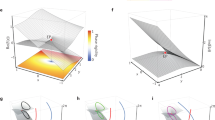Abstract
The present article is a direct continuation of the second part of this series. In conjunction with the analysis of the energy band curves of carbon nanotubes, we develop here fundamental theoretical tools, which are essential to prove the Local Analyticity Proposition (LAP). The LAP enables one to prove the Fukui conjecture (the guiding conjecture for developing the repeat space theory) in a new and powerful context of the theory of algebraic curves and resolution of singularities. The present fundamental tools also serve as modular tools for the repeat space theory, by which one can solve a variety of additivity and molecular network problems in a unifying manner.
Similar content being viewed by others
References
Arimoto S.: New proof of the Fukui conjecture by the functional asymptotic linearity theorem. J. Math. Chem. 34, 259 (2003)
Arimoto S.: Repeat space theory applied to carbon nanotubes and related molecular networks. I. J. Math. Chem. 41, 231 (2007)
Arimoto S.: Repeat space theory applied to carbon nanotubes and related molecular networks. II. J. Math. Chem. 43, 658 (2008)
Arimoto S.: Normed repeat space and its super spaces: fundamental notions for the second generation Fukui project. J. Math. Chem. 46, 589 (2009)
Arimoto S., Spivakovsky M., Taylor K.F., Mezey P.G.: Proof of the Fukui conjecture via resolution of singularities and related methods. I. J. Math. Chem. 37, 75–91 (2005)
Arimoto S., Spivakovsky M., Taylor K.F., Mezey P.G.: Proof of the Fukui conjecture via resolution of singularities and related methods. II. J. Math. Chem. 37, 171–189 (2005)
S. Arimoto, K. Fukui, Fundamental mathematical chemistry, interdisciplinary research in fundamental mathematical chemistry and generalized repeat space, IFC Bull. 7–13 (1998)
Arimoto S., Fukui K., Zizler P., Taylor K.F., Mezey P.G.: Int. J. Quantum Chem. 74, 633 (1999)
Arimoto S., Spivakovsky M., Ohno H., Zizler P., Taylor K.F., Yamabe T., Mezey P.G.: Int. J. Quantum Chem. 84, 389 (2001)
Arimoto S., Spivakovsky M., Ohno H., Zizler P., Zuidwijk R.A., Taylor K.F., Yamabe T., Mezey P.G.: Int. J. Quantum Chem. 97, 765 (2004)
Arimoto S.: Note on the repeat space theory—its development and communications with Prof. Kenichi Fukui. J. Math. Chem. 34, 235 (2003)
Griffiths P.A.: Introduction to algebraic curves. American Mathematical Society, Providence (1989)
Cartan H.: Elementary theory of functions of one or several complex variables. Addison-Wesley, Reading, Mass (1963)
Conway J.B.: A course in functional analysis. Springer, New York (1985)
Author information
Authors and Affiliations
Corresponding author
Additional information
This article is dedicated to the memory of the late Professors Kenichi Fukui and Haruo Shingu.
Rights and permissions
About this article
Cite this article
Arimoto, S. Proof of the Fukui conjecture via resolution of singularities and related methods: III. J Math Chem 47, 856–870 (2010). https://doi.org/10.1007/s10910-009-9605-6
Received:
Accepted:
Published:
Issue Date:
DOI: https://doi.org/10.1007/s10910-009-9605-6




